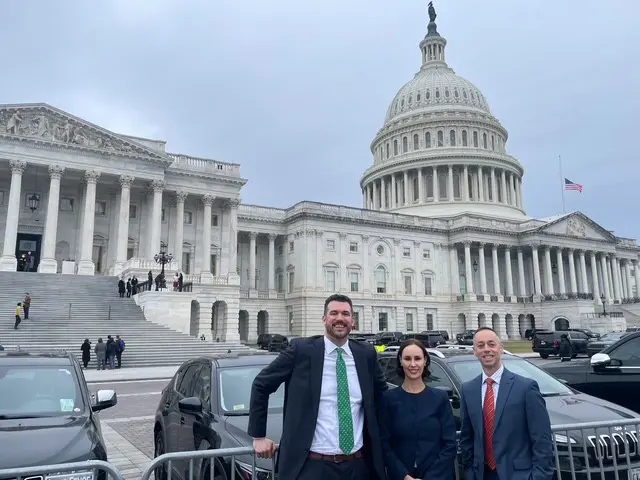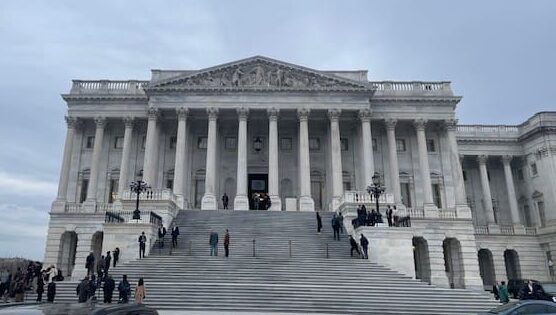American Life’s Jennifer Smith recently joined industry leaders at the IIUSA Congressional Fly-In in Washington, D.C., where EB-5 advocates met directly with congressional offices to highlight the economic impact of the EB-5 Immigrant Investor Program. EB-5 has long been a powerful driver of economic development, particularly in areas with high unemployment and rural regions that often struggle to attract private investment.
Advocating for EB-5 Policy Improvements on Capitol Hill
During the fly-in, participants were organized into teams that met with offices across both the House and Senate. Jennifer’s team connected with representatives from New Jersey, Washington, California, South Carolina, and members of the House Republican Conference—providing a wide, bipartisan perspective on the program’s national value.
Key EB-5 advocacy priorities included:

Middle: Jennifer Smith, American Life, Inc.
Right: Danniel Topple, Customers Bank
- Extending the RIA grandfathering provision to protect investors filing through September 30, 2027. Current law preserves eligibility for investors filing before September 30, 2026, allowing them to complete their immigration process.
- Reauthorizing the EB-5 Regional Center Program, which is essential for sustaining billions in active and future investment and thousands of jobs nationwide.
- Reforming the EB-5 visa allocation so that only principal investors count against the annual visa cap. Currently, family members are included, which reduces the number of investor families able to participate. Only one-third of the total annual allocation of 10,000 visas goes to actual investors. Counting only principals would maximize economic impact and job creation.
- Supporting the EB-5 Regional Center Program Advisory Committee Authorization Act, which has bipartisan backing from Representatives Greg Stanton (D-AZ-04), Brian Fitzpatrick (R-PA-01), and Lance Gooden (R-TX-05). This legislation would establish a formal advisory committee to consult with the USCIS Director on program policy, creating a meaningful dialogue between industry stakeholders and the agency to protect both economic activity and investor interests.
These policy improvements aim to increase program efficiency, protect investors, and maximize the economic benefits EB-5 brings to communities.
EB-5: A Proven Engine for U.S. Economic Growth
The EB-5 Immigrant Investor Program has generated $58 billion in investment and created over 3 million U.S. jobs nationwide. EB-5 capital supports a diverse range of development projects, including:
- Military base redevelopments
- Healthcare and children’s hospitals
- Energy and manufacturing facilities
- Hotel developments, including those serving military communities
- Retail, commercial, and mixed-use real estate projects
These investments bring meaningful economic activity to communities at no cost to taxpayers, making EB-5 a powerful public-private partnership tool.
EB-5’s Impact in Washington State
Washington state continues to be a strong example of EB-5’s value. To date, EB-5 investment has:
- Created an estimated 62,000 jobs
- Attracted $1.9 billion in EB-5 capital
- Leveraged $2.5 billion in total development spending
- American Life currently has active EB-5 projects under construction in Lakewood, Washington and Lancaster, California, both contributing significant local economic benefits.
American Life’s Ongoing Commitment to U.S. Economic Development
For Jennifer, attending the fly-in was especially rewarding. It provided the opportunity to speak directly to congressional members about the EB-5 program’s tangible benefits—benefits that come at no cost to taxpayers. EB-5 immigrants create jobs, contribute to the local tax base, and strengthen communities, allowing elected officials to point to concrete economic development projects in their districts.
The IIUSA Congressional Fly-In demonstrated the critical role of EB-5 in fostering investment, creating jobs, and supporting communities nationwide. For Jennifer Smith and American Life, participating reinforced their commitment to advancing projects that drive economic development while providing opportunities for international investors to contribute to the U.S. economy.
